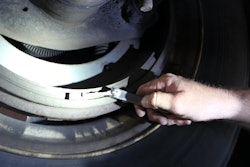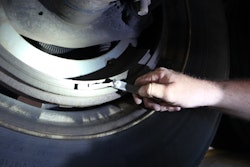Air-conditioning systems tend to get attention only when they under-perform or stop working altogether. As spring gives way to summer and temperatures rise, service technicians can help prevent customers from getting hot under the collar through a few cooling system checks and a little preventive maintenance.
And while regular inspections are important for all vehicles, they take on even greater importance for newer vehicles. One reason is the higher heat rejection of newer emissions-compliant engines. Another is that many new vehicle designs, in an effort to improve aerodynamics and optimize under-the-hood real estate, have stacked configurations of radiator, charge air cooler and condenser.
“Cooling system maintenance is something that probably gets overlooked by a lot of people,” says Mark Taylor, president of ERS Cooling Systems in Glen Burnie, Md. “Airflow is the largest contributor to cooling system failure. Condensers, charge air coolers and radiators are being stacked one in front of the other and if any one of those gets dirty and impedes airflow, then it causes a problem with the other components. People should be checking to make sure these components are clean and free of debris every time they do oil changes – winter or summer.”
ERS Cooling Systems was founded in 1981 and specializes in cooling system service and parts for heavy-duty trucks and equipment. Taylor says that the radiator, charge air cooler and condenser should be visually inspected to make sure they are free of debris, but sometimes that can be tricky.
“Sometimes it’s hard to see,” he says. “You may have to take a mirror and flashlight to be able to look down between them to make sure you’re not getting a debris buildup. Many times we see trucks and pieces of equipment that once we start disassembling these components, we see where there are large areas that are completely blocked up with external debris.”
Vocational vehicles are especially prone to this problem and if the truck has any type of fluid leak, even a minor one, the problem is compounded quickly. When the surfaces of these components get wet, they act like a magnet to dust and dirt.
Taylor says they typically use compressed air to keep the radiator, charge air cooler and condenser clean, but technicians need to use caution so they aren’t just blowing debris from one component into another. His shop designed a special tool to avoid this.
“We’ve made a steel tube with a goose neck on it that we slide down between the components to blow them out the opposite way so that we’re not blowing dirt from one into the other,” Taylor says. “But sometimes they just can’t be cleaned unless they’re disassembled.”
The condenser keeps circulating refrigerant cool in much the same way the radiator keeps coolant cool by transferring heat from the liquid into the atmosphere. When the condenser is not functioning effectively, it’s pretty obvious in the cab on a hot day.
“If the condenser is plugged, the refrigerant will come back around hot and the system won’t blow cold air like the customer expects,” says Frank Burrow, warranty and product support manager for Red Dot Corp. In addition to making sure it is free of foreign material, Burrow suggests inspecting the fins to make sure they are combed out and straight. Bent and mashed fins restrict airflow, diminishing system performance.
“The No. 1 culprit for early compressor failure is excess heat, and that excess heat will be caused by the condensor being either plugged up with debris or the fins being smashed over,” says Taylor.
Fins can get bent in a number of ways, such as a dented grille pushing into the condenser or a technician carelessly handling an uninstalled condenser while cleaning or servicing it. Taylor says a condenser with damaged fins doesn’t always have to be replaced. “If it’s severe enough we do replace them, but other times we use what we call fin combs to comb a lot of the stuff out,” he says. “We also use a little ice pick on the ones that are made like radiators where we will go in and straighten each one individually. It’s a little time consuming, but it can be done.”
Burrow says condensers also fail due to vibration that can shake hose connections loose and stress the condenser tubing adjacent to the fittings. “A routine inspection will highlight the need to clean the condenser, comb the fins and make sure the hose connections are clamped securely,” says Burrow.
Also to be checked at each oil change interval is the receiver-dryer’s moisture indicator in the sight glass. Burrow says a blue dot is good and indicates the refrigerant is dry, while a pink, white or grey dot means acid or moisture is in the system, both of which can damage A/C components.
Not to be overlooked is the component most responsible for HVAC system-related expenses – the compressor, which is responsible for circulating refrigerant and maintaining system pressure. Burrow says an excessively noisy compressor or poor cooling performance are telltale signs the compressor is failing. He recommends using an “all-makes replacement” to reduce the repair costs for the customer and help shops streamline inventory.
Just as a dirty operating environment can cause components to clog, a filthy cab can also wreak havoc on the A/C system.
“Drivers need to keep their cabs clean,” Taylor says. “We see this all the time. Guys have their dogs or their cats or their parrots with them, and they put all this debris down on the passenger side floor, right where the recirculation door is. So all this stuff gets sucked up into the evaporator coil in the dash and plugs it up.”
When the evaporator is plugged, air velocity and cooling efficiency are reduced. Taylor estimates this problem is responsible for about 50 percent of the A/C service work his business performs.
“We see new trucks that are working off road or in quarries and we’re disassembling the evaporator case, pulling the evaporators out and they look like they’re coming out of a truck that is 10 or 15 years old – absolutely stopped up,” Taylor says. “For over-the-road trucks, that will take a lot longer to happen, unless the drivers have a pet that’s riding with them and it starts sucking in a lot of hair. Then we’ve taken them out and they looked like they were growing fur. They looked like gorillas.”
Burrow says the evaporator should be inspected at least annually, and more frequently if the truck operates in a dirty, dusty environment.
Taylor says the evaporator typically can be inspected using a mirror and flashlight. If it needs to be removed to be cleaned, the job takes from two to four hours, depending on the make and model of the vehicle.
Refrigerant Care & Compliance
Shops that service air-conditioning systems need to exercise caution to comply with government regulations and provide a safe working environment. The Mobile Air Conditioning Society (MACS) provides the following reminders about responsible A/C service practices:
- U.S. law requires that anyone who opens the refrigerant pressure circuit for compensation be certified under Section 609 of the Clean Air Act. Technicians must have their certification available while performing this work and shops that allow uncertified technicians to do this work are subject to fines.
- It is unlawful to vent refrigerant into the atmosphere and all refrigerant must be recovered. Refrigerant can be recycled and reused. If the shop is not capable of recycling refrigerant, it must be sent to a reclaiming facility.
- Always use a refrigerant identifier before servicing the system. There are different types of refrigerant and mixing them is prohibited. Each type of refrigerant must be recovered with a specific machine and into properly labeled tanks. Additionally, some gasses may be flammable so technicians need to be cautious.
- Refrigerant in the system does not need to be cleaned as part of maintenance. Refrigerant will be cleaned by normal use of refrigerant recovery and recycling equipment.
- The A/C system does not need additional oil or conditioners and these may even hinder performance or cause damage. Refer to the OEM recommendations to ensure the proper lubricant is used.
- HFC-134a system lubricants are generally polyalkylene glycol-based (PAG) and should not be mixed with other types of oil. Again, refer to the OEM recommendations.
- Refrigerant leaks need to be identified and corrected. Simply replacing the lost refrigerant with new refrigerant contributes to atmospheric pollution and may end up costing customers in the long run.
- Too much refrigerant can reduce cooling performance. Refer to the OEM recommendations and use the correct refrigerant charge, don’t just top-off the system.
- Always use products and chemicals that meet SAE standards.
- Adding a sealer to a leaking refrigerant system has risks and may damage components and service equipment. Additionally, adding substances not approved by the OEM may void warranty.
For additional information, visit www.macsw.org.








